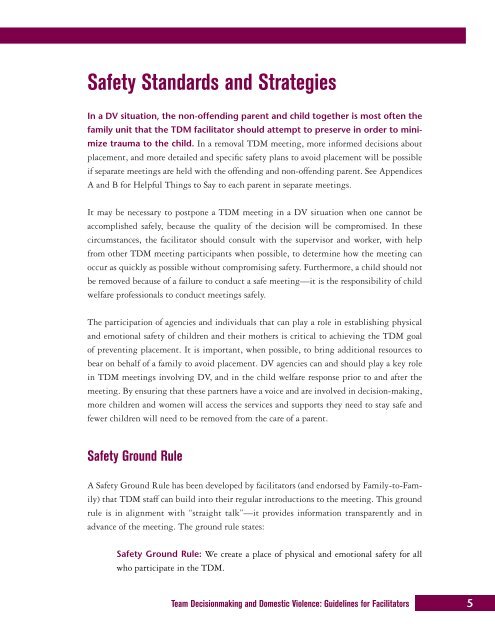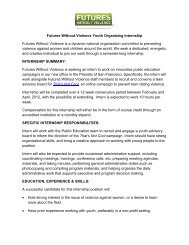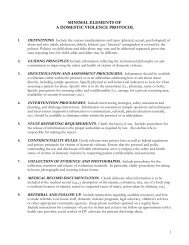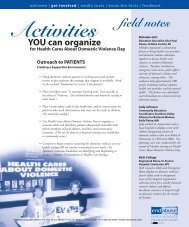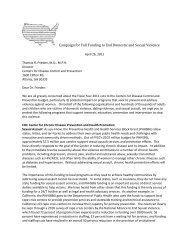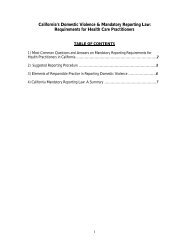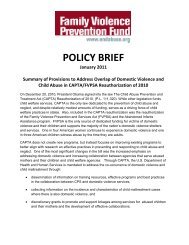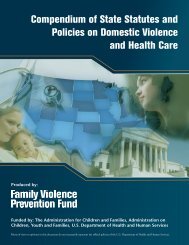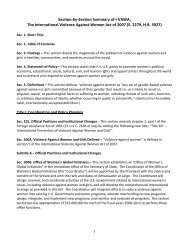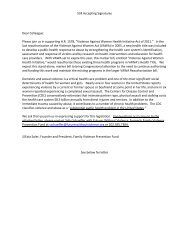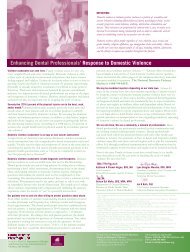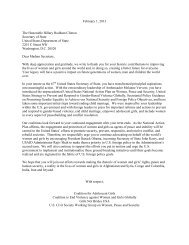Team Decisionmaking and Domestic Violence: Guidelines for ...
Team Decisionmaking and Domestic Violence: Guidelines for ...
Team Decisionmaking and Domestic Violence: Guidelines for ...
You also want an ePaper? Increase the reach of your titles
YUMPU automatically turns print PDFs into web optimized ePapers that Google loves.
Safety St<strong>and</strong>ards <strong>and</strong> Strategies<br />
In a DV situation, the non-offending parent <strong>and</strong> child together is most often the<br />
family unit that the TDM facilitator should attempt to preserve in order to minimize<br />
trauma to the child. In a removal TDM meeting, more in<strong>for</strong>med decisions about<br />
placement, <strong>and</strong> more detailed <strong>and</strong> specific safety plans to avoid placement will be possible<br />
if separate meetings are held with the offending <strong>and</strong> non-offending parent. See Appendices<br />
A <strong>and</strong> B <strong>for</strong> Helpful Things to Say to each parent in separate meetings.<br />
It may be necessary to postpone a TDM meeting in a DV situation when one cannot be<br />
accomplished safely, because the quality of the decision will be compromised. In these<br />
circumstances, the facilitator should consult with the supervisor <strong>and</strong> worker, with help<br />
from other TDM meeting participants when possible, to determine how the meeting can<br />
occur as quickly as possible without compromising safety. Furthermore, a child should not<br />
be removed because of a failure to conduct a safe meeting—it is the responsibility of child<br />
welfare professionals to conduct meetings safely.<br />
The participation of agencies <strong>and</strong> individuals that can play a role in establishing physical<br />
<strong>and</strong> emotional safety of children <strong>and</strong> their mothers is critical to achieving the TDM goal<br />
of preventing placement. It is important, when possible, to bring additional resources to<br />
bear on behalf of a family to avoid placement. DV agencies can <strong>and</strong> should play a key role<br />
in TDM meetings involving DV, <strong>and</strong> in the child welfare response prior to <strong>and</strong> after the<br />
meeting. By ensuring that these partners have a voice <strong>and</strong> are involved in decision-making,<br />
more children <strong>and</strong> women will access the services <strong>and</strong> supports they need to stay safe <strong>and</strong><br />
fewer children will need to be removed from the care of a parent.<br />
Safety Ground Rule<br />
A Safety Ground Rule has been developed by facilitators (<strong>and</strong> endorsed by Family-to-Family)<br />
that TDM staff can build into their regular introductions to the meeting. This ground<br />
rule is in alignment with “straight talk”—it provides in<strong>for</strong>mation transparently <strong>and</strong> in<br />
advance of the meeting. The ground rule states:<br />
Safety Ground Rule: We create a place of physical <strong>and</strong> emotional safety <strong>for</strong> all<br />
who participate in the TDM.<br />
<strong>Team</strong> <strong>Decisionmaking</strong> <strong>and</strong> <strong>Domestic</strong> <strong>Violence</strong>: <strong>Guidelines</strong> <strong>for</strong> Facilitators 5


